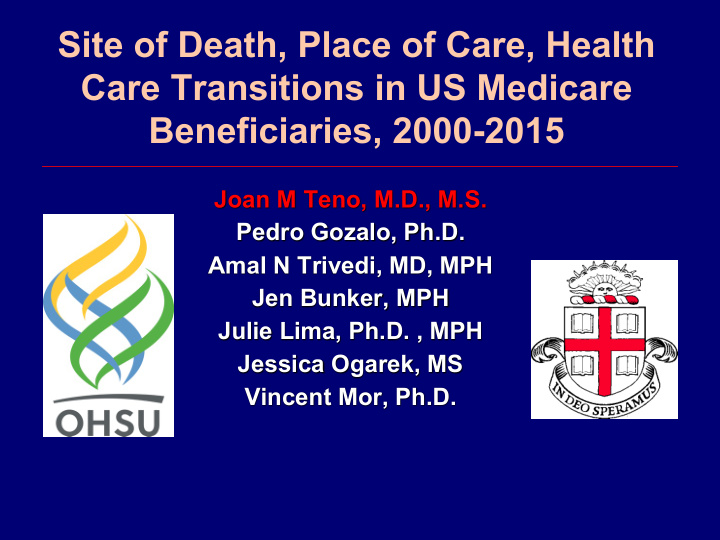



Site of Death, Place of Care, Health Care Transitions in US Medicare Beneficiaries, 2000-2015 Joan M Teno, M.D., M.S. Pedro Gozalo, Ph.D. Amal N Trivedi, MD, MPH Jen Bunker, MPH Julie Lima, Ph.D. , MPH Jessica Ogarek, MS Vincent Mor, Ph.D.
Introduction – Terminal care is costly and there are important concerns with quality of care. – Our previous analysis found decreasing dying in acute care hospital, but more transitions in the last 3 days of life and late referral to hospice.
Impact of Late Transitions Figure 1. Respondent Reports of Quality of Care by Whether Decedent Had No Late Transition, Any Late Transition or an Institution-to-Institution Late Transition No LT Non-Institution LT No Institution-Institution LT 95% CI 3
Research Question • Important changes since 2009 – Continued growth of hospice – Expansion of community-based palliative care teams – 30-day readmission penalty – ACA debate started March 2009 • What was the pattern in site of death, places of care, health care transitions, and burdensome care that occurred between 2000 and 2015? 4
Methods • Sample of 20% Fee-For-Service (FFS) Medicare Beneficiaries and Medicare Advantage (MA) – Age 66 and older – Years studied 2000 and 2015 for FFS – For MA, 2011 and 2015 – 95% CI
Results – Sample Description Characteristic Fee-For-Service N= 1,361,870 Avg. Age 82.8 Gender (%F) 58.7 Race (% Black) 8.0
7
60 Proportion of FFS Decedents 40 20 0 2000 2005 2010 2015 year Hospice <= 3 d Hospice at time of death ICU in the Last 30 d of life Hospitalization in last 30 d NH Stay in the last 90 d of life 8
Potentially Burdensome Transitions Potentially 2009 2011 2015 Burdensome Transition NH to Hospital or 0.58 per 0.36 per 0.33 per Hospital to NH decedent decedent decedent Transition in the 14.2 11.2 10.8 last 3 days of life (%) Multiple hosp. 16.7 11.7 12.2 for infections (%) >=3 Hosp last 90 11.5 6.9 7.1 days (%) 9
MA vs. FFS 2015 60 53.9 50 52.6 50.4 44.6 40 30 29 27.4 20 10 11.2 9.4 0 Hospice ICU Last 30d Transition in last 3 Hosp. Last 30 days days FFS MA
Limitations • Secondary analyses of administrative data – we don’t have information on patient preferences. • Home or community may be a private home, board and care home or personal care home, or an assisted living facility (ALF). Only Hospice can distinguish ALF with place of service code. • MedPAR MA billing data is information only and not available for critical access hospitals and hospitals that serve only MA patients. • Multiple policy and other interventions – difficult to disentangle cause and effect.
Conclusion • Among Fee-For-Service Medicare beneficiaries who died in 2015 compared with 2000, fewer died in an acute care hospital or experienced potentially burdensome transitions, but there was little change in rates of ICU use in the last month of life.
Teno@ohsu.edu Thank you…………
Recommend
More recommend